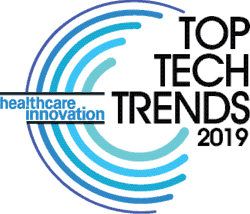How real is artificial intelligence getting now, in U.S. healthcare? Pretty real. So real that the folks who created Clover Health, a Jersey City, N.J.-based PPO/HMO (preferred provider organization/health maintenance organization) in 2014, in order to operate as a Medicare Advantage health plan, created their organization as a health plan with a built-in technology platform—and with artificial intelligence a core part of their strategic planning. And that says everything about the current state of AI in healthcare, which is getting more real by the day now.
And, in that regard, Clover Health has been developing and using data and machine learning approaches to proactively determine which patients are at higher risk for hospitalization or rehospitalization, and can then intervene. Clover Health’s leaders have also used AI and machine learning to identify their highest-risk plan members, and, said Kumar Dharmarajan, M.D., the health plan’s chief scientific officer, speaking at the AHIP Institute & Expo (the annual conference of America’s Health Insurance Plans) in Nashville in June, “We decided to deploy a program for those top 5 percent of plan members, and really take charge of care management for them. So we built out an in-home primary care program.”
What’s more, said Clover chief data scientist Ian Blumenfeld, “You don’t do things just because technologies are cool. I’ve been doing machine learning for a long time, but would never want to build a tool that didn’t have a practical use case,” he testified. “It’s all about the company mission.”
All that said, building machine-learning models is particularly challenging in healthcare, Blumenfeld said at AHIP, because human beings have very complex personal health trajectories, and so creating algorithms and models to predict personal health outcomes is inherently complex and difficult to do. Still, the fact that Blumenfeld, Dharmarajan, and their colleagues at Clover have built a very strong AI-driven tool called CHARM—the Clover Health Acute Risk Model—which has been helping them to accurately determine who the top 5 percent of their plan members are in terms of health risk, and who represent 40 percent of their medical costs—speaks strongly to AI’s overall potential.
“AI is definitely real now,” says Tushar Mehrotra, senior vice president, analytics, at the Eden Prairie, Minn.-based Optum, a health services innovation company. “There’s a difference, though, between real, and fully scaled,” says the Washington, D.C.-based Mehrotra. “We’re looking proactively at addressing AI for the detection of atrial fibrillation, in the cardiology area; meanwhile, imaging, in the radiology area, continues to see advances in the diagnostic use of AI. Both payers and providers are just now beginning to build capabilities in this area. Health plans are hiring the data scientists to help build the capabilities to predict chronic disease incidence and emergence; so they’re ahead of providers. And pharma is the furthest along.” One very practical use that health plan leaders are turning to, he notes, is using AI to predict which parts of which apps health plan members will be using. And, in terms of using AI to leverage social determinants of health data to predict the onset of chronic illness, health plans are “already between a 5 and a 7 on a scale of 10. They realize they need access to claims data and need to partner with their providers on the clinical data to move forward.”
Speaking of the opportunities in the patient care delivery space, “I think the opportunities are in better prediction and diagnosis, and there’s a lot going on in that area right now, because we have the data and reference sets, and AI is powering prediction,” says Tim Zoph, client executive and strategist at the Naperville, Ill.-based Impact Advisors consulting firm. “We’re finally capturing data now to be more precise around targeted treatments. We’re having better conversations about the effectiveness of treatments, and analyzing that effectiveness.”
Indeed, Zoph says, “The data is there, as are the processing power and the storage; the algorithms are evolving forward very quickly.” Still, he adds, “I think the ability to absorb this data, and to overcome individuals’ fears of being replaced, will be challenging.”
Among the recent patient care delivery examples Zoph cites are around using machine-learning algorithms and data fusion techniques to predict blood glucose fluctuation an hour ahead of time, assistance in diagnostic diabetic retinopathy, fueling voice-based clinician-patient encounters with predictive models to understand patients’ psychological states, and using patient-reported outcomes to enable better pre- and post-surgical care, as is taking place now at the Hospital for Special Surgery (an Impact Advisors client) in New York City.
What’s more, things are expected to accelerate dramatically, says Optum’s Mehrotra. “One of the surveys we launched last fall, our inaugural OptumIQ Annual Survey on AI in Health Care, found that, on average, $32.4 million will be invested per organization, on AI, over the next five years. This is going to be a big investment area, and it will continue to grow, particularly in the next three years. And we asked how confident [organizations] were in getting ROI out of this, and 91 percent said they were confident they’d get a positive ROI; 75 percent were already deploying a strategy.
Clover Health’s Dharmarajan agrees. “I think machine learning will be used increasingly for identifying subsets of the population for clinical interventions,” he says. And, says Blumenfeld, “Yes, the same way you’ve seen other types of software get applied, you’ll see this. It’s a little harder than with a standard web application. But there’s so much value in there, I can’t imagine that one wouldn’t want to do this.”
In all this, Impact Advisors’ Zoph says, CIOs “will need to educate and prepare leadership teams and their organization for the culture impact that AI will have on your organizations. What will it mean to be more data-driven? How will we secure the confidence around obtaining data from patients? So, it’s about getting out in front of change processes,” and prepare one’s organization to move forward as a data-driven patient care organization.



